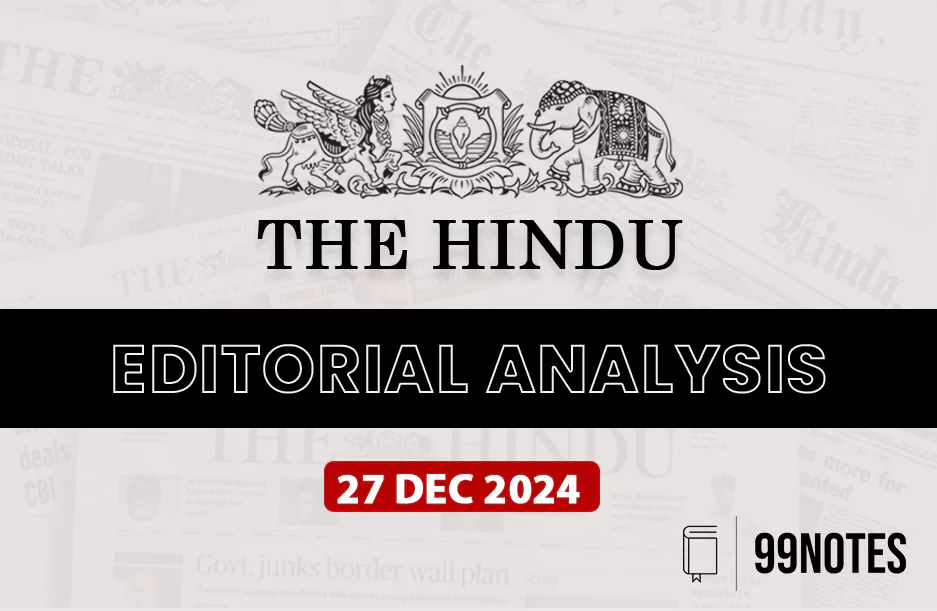27 December 2024 : The Hindu Editorial Analysis
1. Tapping into Kazakhstan’s rare earths potential
(Source – The Hindu, International Edition – Page No. – 8)
|
Context |
|
● The global transition to renewable energy has increased the demand for rare earth elements, critical for clean energy and advanced technologies. ● India, despite significant reserves, relies heavily on imports from China, posing supply chain and security risks. ● Kazakhstan offers a strategic alternative for India to diversify its rare earth supply. |
Global Demand for Rare Earths and India’s Energy Transition
- The transition to cleaner energy has significantly increased the global demand for rare earths.
- India, the third-largest carbon emitter, is pivoting to renewable energy and faces a rising need for rare earth elements.
- Despite being the fifth-largest holder of rare earth reserves, India heavily relies on imports, primarily from China, due to a lack of advanced extraction technologies.
- Supply chain disruptions and security concerns linked to China’s dominance are prompting India to diversify sources through partnerships with the U.S., Latin America, and Africa.
- Kazakhstan emerges as a promising alternative to reduce dependence on China.
China’s Dominance in the Rare Earth Sector
- China possesses over one-third of global rare earth reserves and contributes approximately 70% of global production.
- India sources around 60% of its rare earth imports from China due to limited domestic production.
- China’s control over critical minerals has caused disruptions, such as halting antimony supplies and banning key extraction technologies in December 2023.
- The invasion of Ukraine has further highlighted the risks of concentrated supply chains, with reduced ore supplies from Russia intensifying these concerns.
Kazakhstan as a Strategic Partner for Rare Earths
- Kazakhstan is one of the richest sources of rare earth elements and holds 15 of the 17 known rare earths.
- India’s ‘Connect Central Asia’ policy and initiatives like the International North-South Transport Corridor enhance the potential for collaboration.
- Kazakhstan has advanced extraction technologies and partnerships with countries like Japan, Germany, and the EU.
- The nation’s extraction of elements like dysprosium is expected to grow between 2024 and 2029.
- Kazakhstan’s President has identified rare earths as the “new oil,” emphasizing their economic significance.
- Kazakhstan produces critical materials like beryllium, scandium, tantalum, and niobium, essential for clean energy and telecommunications.
Path to Collaboration and Resource Security
- India’s pledge to achieve 500 GW of renewable energy by 2030 underscores the importance of rare earth elements.
- Plans for a 400% increase in mining output highlight India’s efforts to build capacity across the rare earth supply chain.
- The proposed ‘India-Central Asia Rare Earths Forum’ aims to foster bilateral training, joint mining ventures, and sustainable extraction practices.
- Collaboration with Kazakhstan can enhance India’s resource security, reduce dependence on China, and support sustainability by leveraging regional partnerships.
|
Importance of Rare Earth Minerals for India’s Evolving Economy |
|
● Strategic Resource for Technology: Rare earth minerals are critical for manufacturing electronics, renewable energy technologies, and advanced defense systems, essential for India’s technological aspirations. ● Renewable Energy Transition: Key components like neodymium and dysprosium are used in wind turbines and electric vehicle motors, supporting India’s shift to clean energy. ● Telecommunication Infrastructure: Rare earth elements are vital for producing optical fibers and semiconductors, pivotal for expanding India’s digital economy. ● Defense and Space Industry: Minerals like yttrium and gadolinium are used in missile guidance systems and satellite communication, strengthening India’s strategic capabilities. ● Boost to Manufacturing Sector: Availability of rare earths can reduce import dependence and support initiatives like ‘Make in India.’ ● Economic Diversification: Leveraging domestic resources can attract investments in mining and processing, creating jobs and boosting economic growth. ● Global Geopolitical Leverage: Strengthening rare earth production enhances India’s role in global supply chains, reducing dependence on dominant players like China. |
|
Practice Question: Discuss the strategic importance of rare earth elements for India’s clean energy transition and the challenges posed by dependence on China. How can partnerships with countries like Kazakhstan help address these challenges? (250 Words /15 marks) |
2. Should the wealth tax be reinstated in India?
(Source – The Hindu, International Edition – Page No. – 9)
|
Context |
|
● The debate on reintroducing a wealth tax in India centers around its potential to address rising inequality by funding sectors like health and education. ● Advocates argue for institutional frameworks to ensure effectiveness, while critics cite challenges like wealth measurement, tax evasion, and capital flight. |
Reintroduction of Wealth Tax in India: Debate and Implications
Introduction to Wealth Tax
- Wealth tax is proposed as a means to address inequality and generate revenue for critical sectors like health and education.
- Opponents argue that the challenges of wealth measurement and potential capital flight make it ineffective.
Challenges in Implementing Wealth Tax
- Wealth Measurement Issues: Determining the value of assets, especially non-liquid assets like real estate and gold, is complex.
- Behavioral Impacts: High taxation on liquid assets could incentivize the wealthy to shift their investments to less productive assets.
- Capital Flight: High tax rates on the elite could lead to an exodus of capital and skilled individuals, damaging the economy.
Historical Experience with Wealth Tax in India
- India abolished its wealth tax in 2016-17 due to low collections, which accounted for less than 1% of gross tax revenues.
- The cost of administering and collecting wealth tax outweighed the benefits, with widespread tax evasion complicating enforcement.
Arguments in Favor of Reintroducing Wealth Tax
- Inequality Reduction: High concentration of wealth limits opportunities for a large section of the population, impacting overall development.
- Improved Tracking Systems: Advanced tools and frameworks could address previous inefficiencies and better capture wealth data.
- Global Practices: Other nations, like Norway, have managed wealth taxes with limited capital flight due to strong public infrastructure and services.
Opposition to Wealth Tax
- Focus on Growth: Critics argue that economic growth, not redistribution, is the key to improving social indicators like health and education.
- Public Finance Concerns: Efficient taxation should focus on fewer, broad-based taxes like personal income tax, GST, and property tax.
- Expenditure Effectiveness: Simply channeling wealth tax revenues into sectors like education may not yield significant results due to systemic inefficiencies.
Alternative Approaches to Address Inequality
- Comprehensive Tax Systems: Combining taxes on labor, capital, and real estate at equitable rates could minimize loopholes.
- International Collaboration: Agreements with other countries can improve wealth transparency and reduce evasion.
- Targeted Development Spending: Using tax revenues effectively for public goods and infrastructure could balance growth and redistribution.
Conclusion
- While wealth tax can fund development goals, concerns like its implementation challenges, potential economic impacts, and the effectiveness of expenditure must be addressed.
- The debate underscores the need for a balanced approach that ensures both economic growth and equitable opportunities.
|
Practice Question: Evaluate the feasibility of reintroducing a wealth tax in India, focusing on its potential to reduce inequality and fund social sectors while addressing concerns like capital flight and administrative challenges. (150 Words /10 marks) |
For more such UPSC related The Hindu Editorial Analysis, Check Out –26 December 2024 : The Hindu Editorial Analysis




